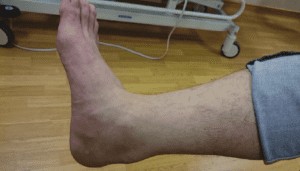Experiencing pain at the back of your heel can be a common and bothersome issue, often interfering with daily activities and exercise. Medically referred to as posterior heel pain, this discomfort can arise from various conditions. This article will explore the primary culprits behind pain in the back of the heel, including Sever’s disease, Achilles tendonitis, different types of bursitis, and Haglund’s deformity. Understanding these conditions can help you identify potential causes and seek appropriate care.
Sever’s Disease: Heel Pain in Active Children
Sever’s disease, or calcaneal apophysitis, is a frequent cause of posterior heel pain in children and adolescents, particularly those aged 8 to 14. This condition is not actually a disease, but rather an inflammation of the growth plate (apophysis) located at the back of the heel bone (calcaneus). During growth spurts, bones grow faster than muscles and tendons, which can lead to tightness and increased stress where the Achilles tendon attaches to the heel.
When young, active individuals engage in activities that place repetitive stress on the heel, especially high-impact sports involving running and jumping, the growth plate can become irritated and painful. Children with Sever’s disease typically describe a deep, bruise-like pain at the back of the heel, which worsens with physical activity and may improve with rest. It can affect one or both heels and is particularly common in sports such as basketball, volleyball, soccer, and gymnastics due to the repeated jumping and landing involved.
Figure 1. Anatomical illustration highlighting the location of the calcaneal apophysis, or growth plate, in the heel bone, the common site of pain in Sever’s disease.
Achilles Tendonitis: Overuse and Inflammation in Adults
In adults, Achilles tendonitis is often the most common reason for pain in the back of the heel. Achilles tendonitis is an overuse injury affecting the Achilles tendon, the large tendon that connects the calf muscles to the heel bone. This condition develops when the Achilles tendon experiences repetitive stress or sudden increases in activity, leading to microscopic tears and inflammation within the tendon fibers.
Individuals with Achilles tendonitis typically experience pain, stiffness, and tenderness along the Achilles tendon, particularly at the back of the heel. The pain often starts gradually and worsens with activity, especially running, jumping, or even prolonged standing. Other symptoms may include reduced ankle flexibility, calf muscle tightness, and sometimes swelling or redness around the heel. Activities that strain the Achilles tendon, such as uphill running, improper footwear, or inadequate warm-up routines, can contribute to the development of Achilles tendonitis.
 Swelling at the back of the heel indicative of Achilles tendonitis.
Swelling at the back of the heel indicative of Achilles tendonitis.
Figure 2. Visual representation of leg swelling due to Achilles tendonitis, demonstrating a common symptom of the condition.
Haglund’s Deformity: The “Pump Bump” Heel Spur
Haglund’s deformity, often referred to as “pump bump” or retrocalcaneal exostosis, is another frequent cause of pain in the back of the heel. This condition is characterized by a bony enlargement or spur on the back of the heel bone, near where the Achilles tendon inserts. The term “pump bump” comes from the fact that this condition is often aggravated by wearing rigid shoes, like pumps, that rub against the bony prominence.
The bony spur itself may not be painful, but it can irritate the soft tissues, including the Achilles tendon and nearby bursae. Wearing shoes, particularly those with a stiff heel back, can cause friction and pressure against the bony spur, leading to inflammation, pain, and the formation of a visible bump on the back of the heel. Haglund’s deformity is more common in middle-aged women but can affect anyone. Pain associated with Haglund’s deformity is often worse after periods of rest and may improve with activity initially, only to worsen again with prolonged standing or walking.
Figure 3. Image clearly showing bilateral Haglund’s deformity, characterized by prominent swelling on the back of both heels.
Achilles Tendon Bursitis: Inflammation of the Heel Bursa
Bursitis is the inflammation of a bursa, a small, fluid-filled sac that acts as a cushion between bones, tendons, and muscles to reduce friction. In the back of the heel, there are two main bursae that can become inflamed and cause pain: the retrocalcaneal bursa and the retro-Achilles bursa.
Retrocalcaneal bursitis involves the bursa located between the Achilles tendon and the heel bone. Retro-Achilles bursitis, also known as superficial Achilles bursitis, affects the bursa situated between the Achilles tendon and the skin. Both types of bursitis can cause pain at the back of the heel, often described as an aching or throbbing sensation that worsens with movement. Symptoms of Achilles tendon bursitis may include swelling, redness, warmth, and tenderness to the touch at the back of the heel. Retrocalcaneal bursitis is often associated with overuse, repetitive activities like uphill running, and conditions like Haglund’s deformity. Retro-Achilles bursitis is frequently triggered by pressure and friction from footwear that rubs against the back of the heel. Sometimes, both types of bursitis can occur simultaneously, contributing to more pronounced heel pain and discomfort.
Figure 4. Anatomical diagram displaying the bursae around the Achilles tendon in the foot, highlighting areas prone to inflammation and posterior heel pain.
Conclusion: Identifying the Cause of Your Heel Pain
Pain in the back of the heel can stem from various conditions, each with its own set of characteristics and causes. Sever’s disease is common in active children, while Achilles tendonitis is frequently seen in adults due to overuse. Haglund’s deformity and Achilles tendon bursitis can also contribute to posterior heel pain, often related to footwear and repetitive stress.
If you are experiencing persistent pain in the back of your heel, it is important to consult with a healthcare professional for a proper diagnosis. Accurate identification of the underlying cause is crucial for developing an effective treatment plan and getting you back on your feet comfortably.
